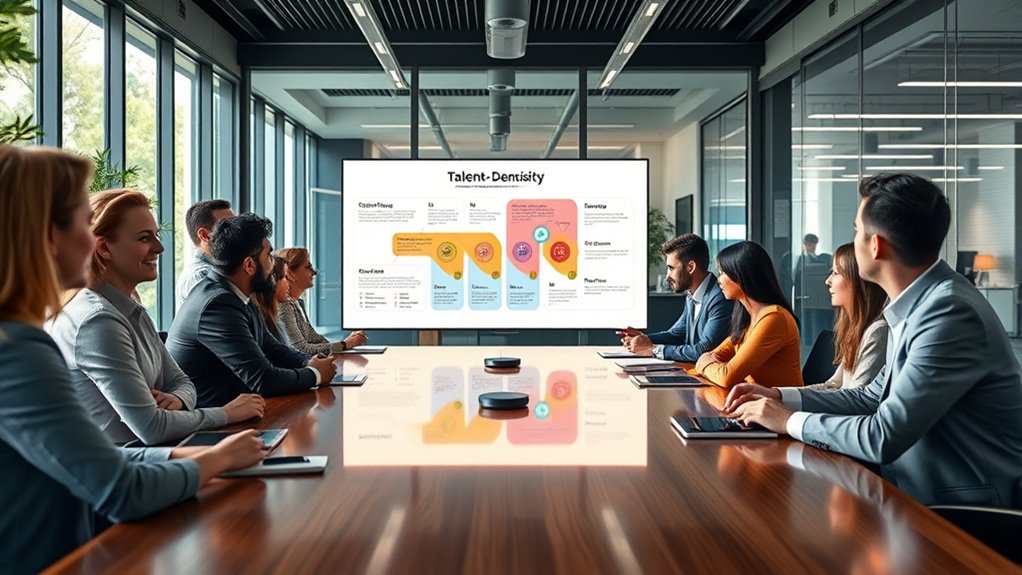The Talent-Density Culture Model centers on building a team of highly skilled, engaged employees who drive innovation, operational excellence, and growth. You focus on strategic hiring, ongoing development, and fostering strong leadership to create a supportive environment that attracts top talent. By emphasizing quality over quantity, you boost collaboration and agility within your organization. To understand how this transformative approach can benefit you, exploring its core principles and strategies can offer valuable insights.
Key Takeaways
- Talent-density culture emphasizes building a concentrated workforce of highly skilled, engaged employees to drive innovation and performance.
- It involves targeted hiring, ongoing skill development, and fostering open communication to maintain a high-performance environment.
- Leadership plays a crucial role by setting standards, modeling behaviors, and promoting continuous growth within the organization.
- The model relies on metrics like engagement, retention, and skill development to measure and refine talent strategies.
- Cultivating a talent-density culture enhances collaboration, operational efficiency, and adaptability for sustained organizational success.
Defining the Core Principles of Talent Density

Talent density is the key to creating high-performing organizations, and understanding its core principles is essential. At its core, talent density emphasizes having a concentrated team of skilled, engaged employees who drive results. When you foster a culture that boosts employee engagement, you naturally improve talent retention, ensuring top talent stays committed. This approach relies on aligning hiring practices, development opportunities, and work environments to attract and keep high-caliber individuals. By prioritizing quality over quantity, you create a workforce where each member adds significant value. The focus isn’t just on filling roles but on building a team with deep expertise and motivation. This foundation enhances organizational agility and resilience, setting the stage for sustained success. Implementing best hiring practices ensures that you continuously attract top talent to maintain high talent density. Additionally, leveraging AI-driven analytics can help identify the most promising candidates and optimize workforce planning. Incorporating a focus on talent quality can further strengthen this model by ensuring that every team member contributes meaningfully to organizational goals. Moreover, understanding organizational behavior can help tailor strategies that enhance employee motivation and collaboration for sustained high performance. Furthermore, fostering a culture that values continuous learning and adaptability aligns with the principles of Cultural Intelligence to support diversity and inclusion within your teams.
The Impact of Talent Density on Organizational Performance

When your organization increases talent density, you’ll notice a boost in innovation as skilled team members collaborate more effectively. Operational efficiency also improves because high-density teams streamline processes and reduce redundancies. Together, these factors markedly enhance overall organizational performance. Additionally, a focus on team dynamics can further amplify these benefits by fostering stronger collaboration and adaptability, which are essential components of leadership skills that drive success. Cultivating a positive work environment and promoting employee well-being can also significantly contribute to sustained high performance within talent-dense teams. Recognizing the importance of support hours and other subtle cues can enhance communication and awareness within teams, leading to better responsiveness and cohesion.
Enhanced Innovation Capabilities
Enhanced innovation capabilities often stem from the concentration of highly skilled individuals within an organization. When talent density is high, your team naturally fosters greater employee engagement, which sparks creative problem-solving. Additionally, this environment accelerates technological integration, making new ideas more accessible and easier to implement. To maximize these benefits, focus on:
- Encouraging open communication to share innovative ideas quickly
- Supporting continuous learning for skill development
- Promoting cross-disciplinary collaboration
- Investing in cutting-edge tools that facilitate technological integration
- Recognizing the importance of vetted ID Times insights to stay informed on industry best practices. A high talent density environment also enhances employee engagement, leading to increased motivation and productivity across teams. This synergy further accelerates innovation adoption, enabling organizations to remain competitive in rapidly evolving markets. As a result, your organization becomes more adaptable and forward-thinking, driving sustained growth. High talent density creates the right conditions for breakthrough innovations, positioning you ahead of competitors and enhancing overall organizational performance. Furthermore, a focus on talent density can lead to more efficient problem-solving and quicker adaptation to market changes.
Increased Operational Efficiency
High concentrations of skilled professionals streamline workflows and reduce inefficiencies, leading to noticeable gains in operational performance. When your team is densely staffed with talent, employee engagement naturally improves because team members feel more connected and motivated. This heightened engagement fosters smoother collaboration and faster decision-making. Additionally, talent density accelerates technology integration, as skilled employees adapt quickly to new tools and processes. As a result, tasks are completed more efficiently, downtime decreases, and overall productivity rises. You’ll notice fewer bottlenecks and better alignment across departments. This efficiency not only boosts performance metrics but also creates a more agile organization capable of responding swiftly to market changes, ultimately strengthening your competitive edge. Moreover, a talent-focused culture encourages ongoing development and innovation, which sustains high performance over time. Recognizing the importance of organizational agility helps organizations adapt to rapid market shifts and evolving industry standards, and fostering a collaborative environment can further enhance team dynamics and innovation. Incorporating training and development programs ensures that talent remains relevant and continuously improves, supporting sustained organizational success. Additionally, maintaining a focus on skill diversification can help organizations respond more effectively to industry changes and technological advancements.
Key Components That Drive Talent Density

You can boost talent density by adopting high-performance hiring strategies that attract top talent. Equally important is fostering continuous skill development to keep your team sharp and adaptable. Well-structured content and consistent updates to your training programs signal a commitment to content relevance and help maintain a competitive edge. Recognizing high-performance equipment can also provide valuable insights into your team’s underlying motivations and emotions, further enhancing talent management strategies. Additionally, understanding the individual responses to various organizational changes can help tailor support and development initiatives more effectively. Incorporating risk assessment for merchant services can aid in identifying potential vulnerabilities within your team’s operational environment, ensuring resilience and stability.
High-Performance Hiring Strategies
Effective hiring strategies are essential for cultivating a talent-density culture, as they directly impact the quality and performance of your team. To attract top talent and boost employee engagement, focus on these key approaches:
- Targeted Talent Acquisition: Focus on sourcing candidates with high skill levels and growth potential.
- Rigorous Selection Processes: Use assessments and interviews that reveal both technical ability and cultural fit.
- Employer Branding: Promote your company’s unique value proposition to attract motivated candidates.
- Candidate Experience: Streamline hiring steps to keep candidates engaged and demonstrate your commitment to their development.
Implementing these strategies enhances your ability to hire high performers, ensuring your team remains competitive and aligned with your talent-density goals.
Continuous Skill Development
How can organizations guarantee that their talent pool continually evolves and remains competitive? The key is fostering a culture of continuous skill development. Encourage peer mentorship, where experienced employees guide others, sharing knowledge and boosting collective expertise. This not only accelerates learning but also strengthens team bonds. Cross training is equally essential; by exposing staff to different roles and responsibilities, you create versatile employees who can adapt quickly to changing needs. Regularly updating training programs and providing access to new learning opportunities ensures your workforce stays current with industry trends. When you prioritize ongoing development through peer mentorship and cross training, you cultivate a dynamic, resilient talent pool that drives sustained growth and innovation.
Strategies for Building a High-Density Talent Culture

Building a high-density talent culture requires intentional strategies that attract, develop, and retain top performers. To boost employee engagement and talent retention, consider these approaches:
Creating a high-density talent culture involves intentional strategies to attract, develop, and retain top performers.
- Offer ongoing learning opportunities that challenge and motivate staff.
- Create a supportive environment where feedback and recognition thrive.
- Align roles with individual strengths to maximize performance and satisfaction.
- Foster a culture of transparency and open communication to build trust.
These tactics help you cultivate a workforce committed to excellence, ensuring your talent density grows. When employees feel valued and engaged, they’re more likely to stay and contribute at high levels. Focus on these strategies consistently to develop a vibrant, high-performing talent culture that drives your organization forward.
The Role of Leadership in Cultivating Talent Density

Leadership plays a pivotal role in shaping and sustaining a high-density talent culture by setting the tone, expectations, and standards for performance. Your commitment to leadership development ensures that leaders actively promote a culture of excellence and continuous growth. By aligning your actions with organizational values, you foster cultural alignment, which reinforces high standards and accountability. Effective leaders inspire and empower talent, encouraging innovation and collaboration that drive overall performance. Your role involves not only identifying and nurturing top talent but also modeling behaviors that reinforce the desired culture. When leadership is intentional and consistent, it creates an environment where talent thrives, and high performance becomes the norm. Ultimately, your leadership sets the foundation for cultivating and maintaining a vibrant talent density.
Measuring and Tracking Talent Density Metrics

Have you established clear methods for measuring and tracking talent density within your organization? Effective metrics help you gauge progress and identify areas for improvement. Consider these key indicators:
Measuring talent density with clear metrics drives progress, inclusion, and innovation in your organization.
- Employee engagement scores – measure how connected and motivated your team feels.
- Diversity metrics – track representation across departments, roles, and levels.
- Skill development rates – evaluate the growth and continuous learning of your talent pool.
- Retention and turnover rates – monitor stability and identify talent gaps.
Regularly analyzing these metrics enables you to adjust strategies, foster an inclusive culture, and optimize talent density. Tracking these indicators ensures you’re building a workplace where talent thrives, engagement soars, and diversity fuels innovation.
Challenges and Pitfalls in Implementing the Model

Implementing the Talent-Density Culture Model often presents unexpected challenges that can hinder progress if not addressed early. One major obstacle is resource allocation; shifting focus to high-talent areas may strain existing resources or create gaps elsewhere. You might find it difficult to balance investments across teams without compromising operational stability. Additionally, maintaining employee engagement can become a pitfall—if staff feel overlooked or undervalued during transformation, resistance or disengagement may rise. Poor communication about the model’s goals can deepen these issues. Without clear strategies to manage resource distribution and foster ongoing engagement, the initiative risks stagnation or failure. Recognizing these pitfalls early allows you to adapt your approach, ensuring smoother implementation and more sustainable talent density growth.
Case Studies of Successful Talent-Density Adoption

Successful adoption of the Talent-Density Culture Model often hinges on strategic planning and clear communication. Take a look at these real-world examples:
- A tech startup prioritized talent acquisition, hiring highly skilled professionals to fuel innovation and deepen cultural integration.
- A financial firm used targeted onboarding to embed its values, ensuring new hires aligned with the talent-density approach.
- An e-commerce company restructured teams around expertise, boosting collaboration and reinforcing cultural cohesion.
- A healthcare organization implemented ongoing training programs, maintaining high standards while fostering a unified culture.
These case studies demonstrate how deliberate talent acquisition strategies and cultural integration efforts can successfully embed the Talent-Density Culture Model into diverse organizations.
Frequently Asked Questions
How Does Talent Density Influence Employee Engagement and Retention?
Talent density directly impacts employee motivation and team cohesion. When your team is filled with highly skilled individuals, motivation increases because employees feel challenged and valued. This strengthens team cohesion, as everyone contributes effectively. Higher talent density reduces turnover because employees see growth opportunities and trust in their colleagues’ capabilities. Ultimately, a dense talent environment creates a positive cycle of engagement and retention, making your organization more resilient and innovative.
What Industries Benefit Most From Implementing the Talent-Density Model?
Think of industries as gardens, where the right mix of talent makes everything flourish. Tech startups and creative agencies benefit most from the talent-density model because it boosts innovation, teamwork, and motivation. When you focus on having high-caliber employees close together, you create a fertile environment for growth. This approach helps attract top talent, improves performance, and keeps your organization competitive in fast-paced markets.
How Can Small Organizations Adopt Talent Density Effectively?
To adopt talent density effectively, focus on strengthening team collaboration and leadership development. You can do this by investing in targeted training that boosts skills and encourages open communication. Cultivate a culture where high performers thrive together, sharing knowledge and supporting each other. As a small organization, streamline processes to foster close-knit teamwork and prioritize leadership growth, helping your team maximize talent density and drive better results.
What Are Common Misconceptions About Talent-Density Implementation?
Many believe talent-density implementation is a quick fix, but myths like it’s just about hiring top talent overlook the real challenges. You might think it’s easy to boost quality without addressing underlying culture or processes, yet implementation challenges often stem from misunderstanding these misconceptions. Don’t fall for myth-based shortcuts; focus on strategic, sustained efforts to truly elevate your organization’s talent density and performance.
How Does Talent Density Intersect With Diversity and Inclusion Efforts?
You might assume talent density only boosts performance, but it also intersects with diversity and inclusion efforts by promoting bias reduction and equitable opportunities. When you focus on building a diverse, high-density team, you foster a culture where varied perspectives thrive, enhancing leadership development. This approach helps you challenge stereotypes, create more inclusive environments, and guarantee everyone’s talents are recognized and cultivated, ultimately strengthening your organization’s overall effectiveness.
Conclusion
Now that you understand the power of a talent-density culture, imagine what your organization could achieve by embracing this model. Will you take the bold steps needed to elevate your team’s skills and performance? The next move could transform your company’s future in ways you never expected. Stay tuned—because revealing this potential might be closer than you think, and the real breakthrough is just around the corner. Are you ready to make it happen?









